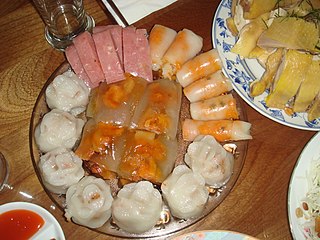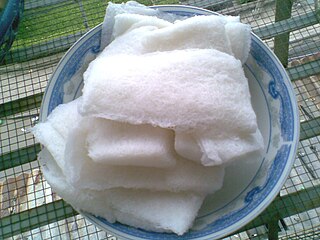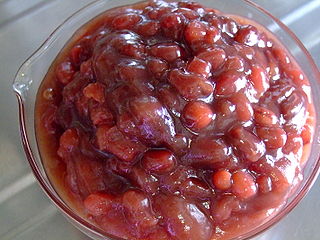This article needs additional citations for verification .(March 2024) |
 | |
| Type | Chinese noodles |
|---|---|
| Place of origin | China |
| Variations | Bánh canh (Vietnam) |
| Lai fun | |||||||||||||||
|---|---|---|---|---|---|---|---|---|---|---|---|---|---|---|---|
| Traditional Chinese | 瀨粉 | ||||||||||||||
| Simplified Chinese | 濑粉 | ||||||||||||||
| |||||||||||||||
This article needs additional citations for verification .(March 2024) |
 | |
| Type | Chinese noodles |
|---|---|
| Place of origin | China |
| Variations | Bánh canh (Vietnam) |
| Lai fun | |||||||||||||||
|---|---|---|---|---|---|---|---|---|---|---|---|---|---|---|---|
| Traditional Chinese | 瀨粉 | ||||||||||||||
| Simplified Chinese | 濑粉 | ||||||||||||||
| |||||||||||||||

Glutinous rice is a type of rice grown mainly in Southeast East Asia, the northeastern regions of India and Bhutan which has opaque grains, very low amylose content, and is especially sticky when cooked. It is widely consumed across Asia.

Malaysian cuisine consists of cooking traditions and practices found in Malaysia, and reflects the multi-ethnic makeup of its population. The vast majority of Malaysia's population can roughly be divided among three major ethnic groups: Malays, Chinese and Indians. The remainder consists of the indigenous peoples of Sabah and Sarawak in East Malaysia, the Orang Asli of Peninsular Malaysia, the Peranakan and Eurasian creole communities, as well as a significant number of foreign workers and expatriates.

Malay cuisine is the traditional food of the ethnic Malays of Southeast Asia, residing in modern-day Malaysia, Indonesia, Singapore, Brunei, Southern Thailand and the Philippines as well as Cocos Islands, Christmas Island, Sri Lanka and South Africa.

Chinese noodles vary widely according to the region of production, ingredients, shape or width, and manner of preparation. Noodles were invented in China, and are an essential ingredient and staple in Chinese cuisine. They are an important part of most regional cuisines within China, and other countries with sizable overseas Chinese populations.

Chinese Indonesian cuisine is characterized by the mixture of Chinese with local Indonesian style. Chinese Indonesians, mostly descendant of Han ethnic Hokkien and Hakka speakers, brought their legacy of Chinese cuisine, and modified some of the dishes with the addition of Indonesian ingredients, such as kecap manis, palm sugar, peanut sauce, chili, santan and local spices to form a hybrid Chinese-Indonesian cuisine. Some of the dishes and cakes share the same style as in Malaysia and Singapore, known as Nyonya cuisine by the Peranakan.

Rice noodles are noodles made with rice flour and water as the principal ingredients. Sometimes ingredients such as tapioca or corn starch are added in order to improve the transparency or increase the gelatinous and chewy texture of the noodles. Rice noodles are most common in the cuisines of China, India and Southeast Asia. They are available fresh, frozen, or dried, in various shapes, thicknesses and textures. Fresh noodles are also highly perishable; their shelf life may be just several days.

Tangyuan are a traditional Chinese dessert made of glutinous rice shaped into balls that are served in a hot broth or syrup. They come in varying sizes, anything between a marble to a ping pong ball, and are sometimes stuffed with filling. Tangyuan are traditionally eaten during the Lantern Festival, but because the name is a homophone for union and symbolizes togetherness and completeness, this dish is also served at weddings, family reunions, Chinese New Year, and the Dōngzhì festival.

Bánh canh are a thick Vietnamese noodles that can be made from tapioca flour or a mixture of rice and tapioca flour. "Cake" refers to the thick sheet of uncooked dough from which the noodles are cut.

A rice noodle roll, also known as a steamed rice roll and cheung fun, and as look funn or look fun in Hawaii, is a Cantonese dish originating from Guangdong Province in southern China, commonly served as either a snack, small meal or variety of dim sum. It is a thin roll made from a wide strip of shahe fen, filled with shrimp, beef, vegetables, or other ingredients. Seasoned soy sauce – sometimes with siu mei drippings – is poured over the dish upon serving. When plain and made without filling, the rice noodle is also known as jyu cheung fun, literally "pork intestine noodle", a reference to its resemblance of a pig's intestines. There is no official recording of the history of rice noodle rolls; most cookbooks claim that it was first made in the 1930s. In Guangzhou, Guangdong Province, people called the dish laai cheung because it is a noodle roll that pulled by hand.

Vietnamese cuisine includes many types of noodles. They come in different colors and textures and can be served wet or dry, hot or cold, and fresh (tươi), dried (khô), or fried.

Silver needle noodle, rat noodle, bee tai bak, runny nose vermicelli or lot, giam ee (เกี้ยมอี๋) is a variety of Chinese noodle. The noodles are short, about 5 cm long and 5 mm in diameter, and white semi-transparent in colour. The noodles are available in many Chinese markets in Chinese populated areas such as Hong Kong, Taiwan, Cambodia, Indonesia, Malaysia, Thailand, Vietnam and Singapore.

Rice flour is a form of flour made from finely milled rice. It is distinct from rice starch, which is usually produced by steeping rice in lye. Rice flour is a common substitute for wheat flour. It is also used as a thickening agent in recipes that are refrigerated or frozen since it inhibits liquid separation.

In Vietnamese, the term bánh translates loosely as "cake" or "bread", but refers to a wide variety of prepared foods that can easily be eaten by hands or chopsticks. With the addition of qualifying adjectives, bánh refers to a wide variety of sweet or savory, distinct cakes, buns, pastries, sandwiches, and other food items, which may be cooked by steaming, baking, frying, deep-frying, or boiling. Foods made from wheat flour or rice flour are generally called bánh, but the term may also refer to certain varieties of noodle and fish cake dishes, such as bánh canh and bánh hỏi.

Javanese cuisine is the cuisine of Javanese people, a major ethnic group in Indonesia, more precisely the province of Central Java, Yogyakarta and East Java.

Bánh hỏi is a Vietnamese dish consisting of rice vermicelli woven into intricate bundles and often topped with chopped scallions or garlic chives sauteed in oil, served with a complementary meat dish. The strings of noodles are usually only as thin as a toothpick; the texture is firm enough so the noodles do not fall apart but is not at all sticky to keep the dish light.

Red bean paste or red bean jam, also called adzuki bean paste or anko, is a paste made of red beans, used in East Asian cuisine. The paste is prepared by boiling the beans, then mashing or grinding them. At this stage, the paste can be sweetened or left as it is. The color of the paste is usually dark red, which comes from the husk of the beans. In Korean cuisine, the adzuki beans can also be husked prior to cooking, resulting in a white paste. It is also possible to remove the husk by sieving after cooking, but before sweetening, resulting in a red paste that is smoother and more homogeneous.

Palembangese cuisine is the cuisine of the Palembangese people of the city of Palembang in the South Sumatra province of Indonesia. It is the second most well-known cuisine from Sumatra after Padang.